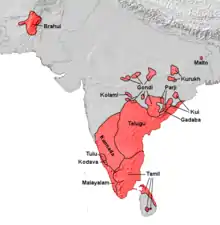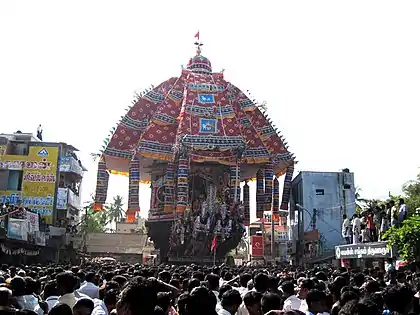Hinduism in South India
Hinduism in South India refers to the Hindu culture of the people of South India. The Hinduism in South India is characterized by Dravidian customs and traditions. The Dravidians made great contributions to development of Hinduism.[1] South India was the birthplace of many Hindu saints and reformers. The Brahmins (Hindu priests class) of ancient South India (Tamilakam, Telangana, Karnataka) were classified as Pancha-Dravida (The Five Dravidians).[2][3] The Hindus in South India are followers of various Hindu branches such as Shaivism, Vaishnavism, Shaktism, Brahmanism and others. Hinduism was the state religion of most of the South Indian kingdoms. During the Ancient and Middle Ages were built in South India one of the greatest Hindu temples. South Indian kings such as the Cholas spread Hinduism overseas to parts of Southeast Asia.[4] The activities of South India across the Palk Strait led to survival of Hinduism in Sri Lanka.[5] The Tamil Hindus in Sri Lanka are followers of Tamil Shaiva Siddhanta, which is mainly practiced in parts of South India. Some Hindu festivals are celebrated mostly or exclusively in South India and Sri Lanka. In South India are also numerous Hindu pilgrimage site that is visited annually by thousands of devotees.[6] The Cauvery River that flows through Karnataka and Tamil Nadu is also known as the "Ganges of South" and is one of the most sacred river of the Hindus.[7]
| Part of a series on |
| Dravidian culture and history |
|---|
 |
| Portal:Dravidian civilizations |
Hinduism in Ancient South India

The Vedic culture in South India has been in some respects the best preserved of ancient Vedic culture and traditions. In North India during late ancient and medieval periods, Buddhism, Sikhism and Islam flourished alongside the Hindu majority. Every intermixing influenced North Indian culture, in particular Islam. The influence of Islam, specifically Sufism, and Sikhism are widespread in the modern-day North Indian society, clearly palpable in linguistics, music, attire, etc. Much of this influence can be attributed to close to a millennium of Muslim rule across North India. Unlike in the North, South India had less outside influence until the advent of European imperialists. As such the original Hindu traditions are relatively better preserved in South India than in North India.
Tamil literature and Tamil epics and classics have many references to Vedic gods and culture. The Tolkaappiyam, 1st century BCE grammar book, mentions non-Vedic, early-Vedic (Indra, Varuna) and Puranic (Vishnu) gods. The Paripadal (8; 3; 9 etc.), one of the "Eight Anthologies" of poetry (or ettuttokai), has homages to Vishnu, Lakshmi, Brahma, the twelve Adityas, the Ashvins, the Rudras, the Saptarishis, Indra, the Devas etc. The Kural, written by Tiruvalluvar, mentions gods like Indra (25) and Lakshmi (e.g. 167).
The Sangam Tamil epic Silappathikaram, begins with invocations to Chandra, Surya, and Indra, and has homages to Agni, Varuna, Shiva, Subrahmanya, Vishnu-Krishna, Uma, etc. The epic states that "Vedic sacrifices [are] being faultlessly performed" and has many references to Vedic culture and Vedic texts. In the Buddhist work Manimekhalai, the submersion of the city Puhar in Kumari Kandam is attributed to the neglect of the worship to Indra.
Vedic legends
According to the Puranas, the Dravidians are descendants of the Vedic Turvasha people. According to the Matsya Purana, Manu is considered as a south Indian king.[8] In Hindu tradition the creation of the Tamil language is credited to the Rig Vedic sage Rishi Agastya.[9]
References
- Eliot, Charles (2007). Hinduism and Buddhism, Vol I. (of 3). Echo Library. p. 12.
- Nārada Maha Thera, The Buddha-Dhamma Or the Life and Teachings of the Buddha, p.8
- James G. Lochtefeld, The Illustrated Encyclopedia of Hinduism: A-M, p.205
- Dorling Kindersley, India: People, Place, Culture, History, p.85
- Lecture on Hindu sculpture and architecture of Sri Lanka Sunday Times - 29 September 2010 Archived 12 October 2012 at the Wayback Machine
- "Ghazal programme at Tirumala temple". The Hindu. Chennai, India. 30 September 2003.
- Sunita Pant Bansal, Hindu Pilgrimage, p.6
- also e.g. Bhagavata Purana (VIII.24.13)
- Michel Danino - Vedic Roots of Early Tamil Culture Archived 2013-08-17 at the Wayback Machine